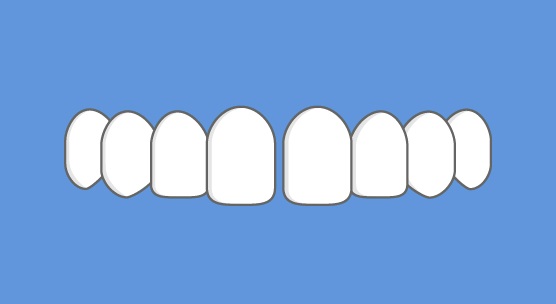Navigation
Gapped teeth
It’s common for there to be a gap between two of your teeth. If a gap is wider than 0.5cm, it’s known as a diastema. Diastemas are most frequently noticed between the top front two teeth. The diagram shows what a diastema looks like.

What causes gapped teeth?
There are many causes of gapped teeth. These include:
![]()
Genetics: Gapped teeth can run in the family
![]()
Gum disease: If you have severe gum disease, this can result in damage to the jawbone and your teeth may become loose, causing gaps to appear
![]()
Alignment issues where your front teeth protrude past your lower teeth
![]()
The loss of baby teeth: As these fall out, gaps can appear between a child’s teeth. These sometimes close as adult teeth appear or they can remain permanently
![]()
Oversized tissue in the gum: You have a type of tissue between your lip and gum known as ‘labial frenum’. If this is too large, it can cause a gap to form
![]()
Pushing your tongue against your front teeth or thumb sucking beyond the age of seven: This can put enough pressure on the front teeth to result in a gap
![]()
Can gapped teeth cause oral health problems?
Generally, a gap between your teeth is nothing to worry about and many people like the look of a diastema. However, if you feel self-conscious about it, you may want to have orthodontic treatment for cosmetic reasons.
Most of the time, a gap in the teeth can be treated with braces, but there are some cases, for example if the gap is caused by oversized tissue, where you may require a minor operation such as a frenectomy to close the gap.
If you have gum disease, this will need to be treated by your general dentist before you can have any type of orthodontic treatment, or you may want to replace the failing teeth instead.
![]()
Which type of braces can fix gapped teeth?
Your orthodontist may discuss the following options with you:
- Fixed braces, which use brackets and wires to reposition your teeth. These can come in the form of traditional metal braces, or more discreet options such as clear ceramic braces or lingual braces
- Invisalign treatment or other types of removable braces, which uses clear aligners that you can take out to eat, drink or to brush your teeth
Spread the cost of your treatment†
Get the straighter smile you’ve always wanted with finance options that suit you, including 0% APR up to 36 months or 7.9% APR over 48 or 60 months.
Ask us about hassle-free finance with Novuna Personal Finance today. T&Cs apply.
What to expect
When we contact you, we will ask you if you’d like to have your free consultation in person or over the phone. At your consultation, we will chat through your options and suitability for different treatments.
*Terms and conditions:
1. Consultations over the telephone or a video application are free of professional charges. A COVID-19 safety tariff will not apply to the free consultation but may apply to specific appointments in your treatment, which you will be notified of beforehand.
2. Consultations are to discuss options and suitability for treatment. Subsequent clinical examinations and diagnostic tests required, and any associated costs will be discussed prior to treatment commencing.
3. Consultations subject to availability.
We recognise that when you give us personal information (which includes health information) you’re trusting us to take good care of it. Please see www.bupa.co.uk/privacy for more information about how we collect, use and protect your data.
If you don’t want to receive marketing about Bupa products and services that we think are relevant to you, please contact us at [email protected].
Find out more
Teeth straightening
Everything you need to know about getting a straighter, healthier and more confident smile.
Fixed braces
Fixed braces are attached to your teeth using wires and brackets and are a popular treatment option.
Removable and near-invisible braces
Find out more about the discreet, clear aligner options we have available at Total Orthodontics.
Our orthodontists
†Finance terms and conditions:
Finance applicant must be aged 18 or over, a UK resident, have a UK bank account and be in permanent employment. All loans are subject to eligibility, status, affordability and a credit check. T&Cs apply. Finance is available on private dental treatments only.
The minimum spend for finance is £250 and the maximum is £50,000. 0% APR representative is available on repayment terms of up to 36 months subject to the amount of credit. Finance taken at repayment terms of 48 or 60 months is subject to 7.9% APR representative.
Total Orthodontics and Bupa Dental Care are trading names of Oasis Dental Care Limited, Vantage Office Park, Bristol, BS16 1GW, whose company registered number is 00478127. Oasis Dental Care Limited is authorised and regulated by the Financial Conduct Authority FCA registration no: 710559. Oasis Dental Care Limited is a credit broker and not a lender.
Finance is provided by Novuna Personal Finance, a trading style of Mitsubishi HC Capital UK PLC, authorised and regulated by the Financial Conduct Authority. Financial Services Register no. 704348. Registered Office: Novuna House, Thorpe Road, Staines-upon-Thames, Surrey, TW18 3HP. Registered in Cardiff under company no. 1630491. The register can be accessed through; http://www.fca.org.uk/.